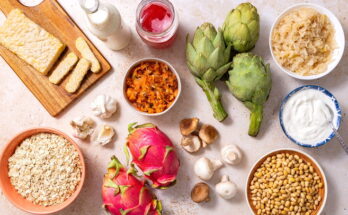Croissant Recipe: Croissants, those buttery, flaky pastries we all adore, are a staple of French baking. They embody both simplicity and sophistication, making them perfect for breakfast, brunch, or as a snack.
But have you ever considered making croissants at home? With this guide, you’ll not only learn the step-by-step process but also enjoy a detailed video tutorial to make the journey easier.
A Brief History of Croissants
The origins of croissants are fascinating. While often associated with French cuisine, croissants actually trace their roots back to Austria. The “kipferl,” a crescent-shaped pastry, was a precursor to the modern croissant. It wasn’t until the 19th century that the French adopted and perfected the recipe, giving it its signature flaky layers.
Why Homemade Croissants Are Worth the Effort
Homemade croissants offer a level of freshness and flavor that’s hard to match. Sure, they’re available in bakeries, but crafting them yourself is an experience. You control the quality of ingredients, the lamination process, and ultimately, the taste. Plus, there’s immense satisfaction in watching your croissants rise and bake to golden perfection.
What Makes the Perfect Croissant?
Perfect croissants are all about texture and flavor. The exterior should be crisp and golden, while the interior reveals delicate, airy layers. Achieving this requires precision, patience, and top-notch ingredients. From the buttery aroma to the satisfying crunch, every bite should feel like a little piece of Paris.
Essential Ingredients for Croissants
To make authentic croissants, you’ll need just a handful of ingredients, but each one plays a crucial role in the final product.
Basic Ingredients Breakdown
- Flour: Use high-quality all-purpose or bread flour for the best structure.
- Butter: European-style butter is ideal due to its higher fat content.
- Milk: Full-fat milk adds richness to the dough.
- Sugar: Provides a subtle sweetness to balance the butter.
- Salt: Enhances flavor and balances sweetness.
- Yeast: Active dry yeast ensures proper rising.
Importance of Quality Ingredients
Since croissants rely on a few basic components, their quality is critical. Using premium flour and butter, for example, makes a noticeable difference in flavor and texture. Fresh yeast and high-fat butter create those irresistible, flaky layers.
Ingredient Substitutions and Tips
- For a dairy-free version, opt for vegan butter and plant-based milk.
- If European butter isn’t available, use unsalted butter but adjust the salt.
- Want more sweetness? Add a tablespoon of honey to the dough.
Tools You’ll Need
Equipping your kitchen with the right tools will make the process smoother and more enjoyable
Baking Tools for Success
You’ll need:
- Rolling pin
- Dough scraper
- Measuring cups and spoons
- Pastry brush
- Parchment paper or silicone baking mats
Special Equipment for Lamination
Lamination is the process of folding butter into dough to create layers. To do this effectively:
- Chill the rolling pin: A cold rolling pin prevents butter from melting.
- Dough ruler: Ensures consistent thickness for even baking.
Preparation and Workspace Setup
A clean, cool workspace is essential. Keep your tools and ingredients chilled to avoid over-softening the butter. Plan for ample counter space to roll out and fold the dough without interruptions.
Step-by-Step Guide to Making Croissants
Mastering croissants involves several key stages, each requiring patience and precision.
Step 1: Preparing the Dough
Start by mixing your flour, sugar, salt, and yeast in a large bowl. Warm the milk slightly and add it to the dry ingredients, forming a cohesive dough. Knead until smooth, then let it rest in the fridge for at least an hour.
Step 2: Making the Butter Block
Cut cold butter into slices and arrange them on parchment paper. Flatten and shape it into a square. This butter block will later be folded into the dough to create those signature layers.
Step 3: Laminating the Dough
Lamination is the magic behind the croissant’s flaky layers. Here’s how to do it step by step:
- Roll Out the Dough: After chilling, roll the dough into a rectangle large enough to encase the butter block.
- Enclose the Butter: Place the butter block in the center of the dough. Fold the dough edges over it like a letter, ensuring the butter is fully sealed inside.
- First Roll and Fold: Roll the dough into a long rectangle. Fold it into thirds like a letter, creating the first “turn.” Chill the dough for 30 minutes to let the butter firm up again.
- Repeat for More Layers: Repeat the rolling and folding process two more times, chilling the dough between each turn. This creates the signature layers.
Step 4: Shaping the Croissants
Shaping the croissants is where your dough begins to transform into the recognizable crescent shape:
- Roll Out the Laminated Dough: Roll the dough into a large rectangle about 1/8 inch thick.
- Cut Triangles: Using a sharp knife or pastry cutter, slice the dough into long triangles. The base should be about 4 inches wide.
- Roll into Crescents: Starting from the base of each triangle, roll the dough toward the tip to form a crescent. Ensure the tip is tucked underneath to maintain the shape during proofing and baking.
Step 5: Proofing the Croissants
Proofing allows the croissants to rise and develop their airy texture:
- Arrange on a Baking Tray: Place the shaped croissants on a parchment-lined baking sheet, leaving space between them.
- Cover and Let Rise: Cover the tray with a clean kitchen towel or plastic wrap. Let the croissants proof in a warm, draft-free area for 1.5 to 2 hours. They should double in size and feel light and airy.
Step 6: Baking to Golden Perfection
The final step is baking your croissants to golden, flaky perfection:
- Preheat the Oven: Heat your oven to 375°F (190°C). Ensure it’s fully preheated for even baking.
- Brush with Egg Wash: Whisk an egg with a splash of water or milk. Gently brush the croissants to give them a shiny, golden finish.
- Bake: Place the tray in the oven and bake for 15-20 minutes or until the croissants are deep golden brown.
- Cool Slightly: Let the croissants cool on a wire rack for a few minutes before serving.
Video Guide for Visual Learners
Videos can bridge the gap between theory and practice, especially for intricate recipes like croissants.
Why Video Tutorials Enhance Learning
Watching a video helps you grasp the nuances of croissant-making. From rolling techniques to the right dough consistency, seeing it in action makes the process less intimidating.
Key Moments to Watch in the Video
- How to properly laminate the dough without tearing it.
- Tips for achieving uniform triangles for shaping.
- The egg wash application for an even golden finish.
Accessing the Video Tutorial
Check out the accompanying video to follow along with this guide. It’s embedded below and offers detailed demonstrations of each step.
Pro Tips for Mastering Croissants
Even with a clear recipe, making croissants can be tricky. These pro tips will help ensure success.
Troubleshooting Common Issues
- Butter Melting During Lamination: Always work with chilled tools and dough to prevent butter from oozing out.
- Croissants Not Rising: Check the freshness of your yeast and ensure the proofing environment is warm but not hot.
- Uneven Layers: Roll the dough evenly during lamination and avoid overworking it.
Enhancing Flavor and Texture
- Add a pinch of cardamom or cinnamon to the dough for a subtle flavor boost.
- Use cultured butter for a slightly tangy, rich taste.
- Chill the dough overnight before shaping for enhanced flavor.
Timing and Patience for Best Results
Making croissants is a labor of love. Allocate plenty of time and don’t rush through the chilling or proofing steps. The slower the process, the more flavorful and flaky the croissants.
Variations and Fillings
Once you’ve mastered the classic croissant, explore these creative variations to wow your taste buds.
Sweet Variations
- Chocolate Croissants: Add a strip of dark chocolate before rolling the dough.
- Almond Croissants: Fill with almond paste and top with sliced almonds.
- Fruit-Filled Croissants: Use jams or fresh fruit for a burst of sweetness.
Savory Variations
- Cheese and Herb Croissants: Add shredded cheese and fresh herbs before shaping.
- Ham and Cheese: Insert slices of ham and Swiss cheese into the dough.
- Spinach and Feta: A Mediterranean twist perfect for brunch.
Creative Croissant Innovations
- Croissant Donuts (Cronuts): Deep-fry croissant dough for a decadent treat.
- Stuffed Croissants: Experiment with Nutella, peanut butter, or caramel.
- Mini Croissants: Perfect for parties and gatherings.
Serving Suggestions
Croissants are versatile and pair wonderfully with a variety of accompaniments.
Pairing Croissants with Beverages
- Coffee or espresso is a classic choice.
- Hot chocolate makes a comforting match for sweet variations.
- Tea, especially Earl Grey or herbal blends, complements croissants beautifully.
Breakfast, Brunch, and Beyond
- Serve plain croissants with butter and jam for a classic breakfast.
- Pair with soups or salads for a light lunch.
- Use as a base for sandwiches for an indulgent twist.
Storing and Reheating Tips
- Store leftover croissants in an airtight container for up to 2 days.
- Reheat in a preheated oven at 350°F (175°C) for 5-7 minutes to restore their crispiness.
- Freeze unbaked croissants and bake fresh as needed.
FAQs about Croissant Recipe
1. What is a croissant?
A croissant is a buttery, flaky pastry originating from France. Made with a yeast-leavened dough, it is laminated with layers of butter to achieve its characteristic texture.
2. What ingredients are needed to make croissants?
To make croissants, you’ll need basic baking staples such as flour, sugar, salt, yeast, milk, butter, and eggs. High-quality butter is essential for achieving the rich, flaky layers.
3. Can I make croissants at home?
Yes, croissants can be made at home with patience and practice. The key is to follow the laminating process carefully, which involves folding and rolling the dough multiple times with butter.
4. How long does it take to make croissants?
Making croissants typically takes 2-3 days, including time for chilling and proofing the dough. The process requires precision but is worth the effort for the delicious results.
5. Why are my croissants not flaky?
Croissants may not turn out flaky if the butter melts during the laminating process or if the dough isn’t chilled adequately between folds. Ensure a cold working environment and use proper technique.
6. Can croissants be frozen?
Yes, croissants can be frozen at different stages. Freeze unbaked croissants after shaping to bake fresh later, or freeze baked ones and reheat them when needed.
7. What variations can I try with croissants?
Croissants can be made plain or filled with sweet or savory ingredients like chocolate, almond paste, cheese, or ham. Experiment with flavors to create your favorite version.
8. How do I serve croissants?
Croissants are best served warm, either on their own or with accompaniments like butter, jam, or coffee. They’re perfect for breakfast, brunch, or as a snack.
Conclusion
Homemade croissants are a culinary triumph worth every minute of effort. With this step-by-step guide and video tutorial, you can create bakery-quality croissants right in your kitchen. Whether you enjoy them plain or stuffed with your favorite fillings, these buttery delights are sure to impress.



